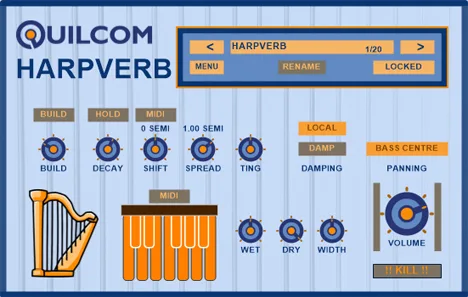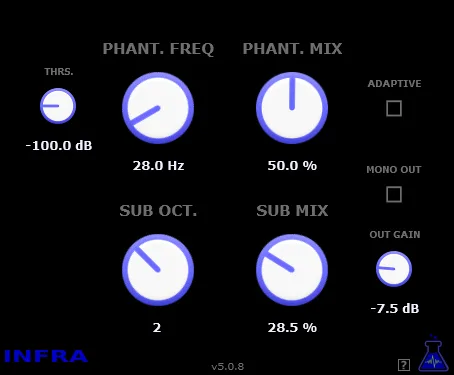Quilcom Harpverb: Discover the World of Sympathetic String Resonance
In the world of digital audio production, the search for unique tools that allow you to go beyond standard effects is a constant pursuit for musicians and sound designers. Quilcom Harpverb is just such a tool. It’s not just another reverb plugin; it’s a specialized effect designed to imitate the beautiful and complex phenomenon of sympathetic string resonance.
Imagine an acoustic guitar, harp, or grand piano with the sustain pedal pressed down. If you make a loud sound nearby, you will hear the strings that are not being played directly begin to vibrate in response. This happens because sound waves from an external source excite the strings whose frequencies are multiples of or close to the frequencies of the external sound. This “sympathetic” resonance adds richness, body, and a special “live” feel to the sound. Quilcom Harpverb masterfully emulates this effect in your digital audio workstation.
Innovative Architecture: 61 Customizable Resonators
At the heart of Quilcom Harpverb is its unique architecture, which is fundamentally different from standard reverbs that use algorithms based on imitating sound reflections off surfaces. Instead, Harpverb uses a bank of 61 high-quality comb filters. Each of these filters functions as a resonant element tuned to a specific frequency – essentially, imitating a separate string of a chromatic series.
- Detailed Emulation: 61 filters allow you to cover a significant musical range, accurately reproducing the resonance in response to the input signal.
- String Character: The result is not a scattered echo, but a clearly expressed “string” resonance, which adds chime, body, and harmonic richness.
- Not Just Reverb: Although the effect is classified as a reverb, its sound is unique and can be used to achieve textures unavailable by traditional means. It’s more of a “resonator” or a “sympathetic vibration simulator.”
Control and Flexibility: MIDI and Panel
Quilcom Harpverb offers convenient and intuitive controls.
- MIDI Input: A key feature is the presence of a MIDI input. This allows you to use external MIDI controllers, in particular, a sustain pedal. By connecting a MIDI pedal, you can control the damping of the “virtual strings” in the same way as on a real piano, adding expressiveness and dynamics to your parts. This is ideal for working with keyboard sounds.
- Control Panel: All the parameters of the plugin are available on a visually clear front panel. You can precisely adjust the “timbre” of the resonance, its duration, and intensity.
- Going Beyond: Controls allow you not only to accurately simulate sympathetic resonance but also to experiment, creating unique sounds that go beyond this model. This makes Harpverb a powerful sound design tool.
Areas of Application and Creative Potential
Quilcom Harpverb is a versatile tool that can find its place in a variety of musical genres and sound engineering tasks.
- Classical and Neoclassical: Give digital pianos or stringed instruments realistic acoustic resonance.
- Ambient and New Age: Create deep, meditative textures with a vibrating, ringing character.
- Electronic Music: Add unusual resonant layers to synthesizer sounds. Use it to create unique transition effects or atmospheric intros/outros.
- Sound Design for Film and Games: Generate original sounds that imitate the vibration of metal, glass, or other resonating objects.
- Pop and Rock Music: Use to add “air” and body to acoustic instruments or vocals.
Conclusion
Quilcom Harpverb from Quilcom is an innovative VST effect for Windows (Win32), which offers a fresh look at sound processing. Instead of imitating space, it focuses on simulating a physical phenomenon – sympathetic string resonance. Its unique architecture, MIDI integration, and flexible controls make it a powerful tool for adding depth, texture, and original character to your audio projects. If you are ready to experiment and look for new sound solutions, Quilcom Harpverb will be a valuable addition to your plugin collection.



